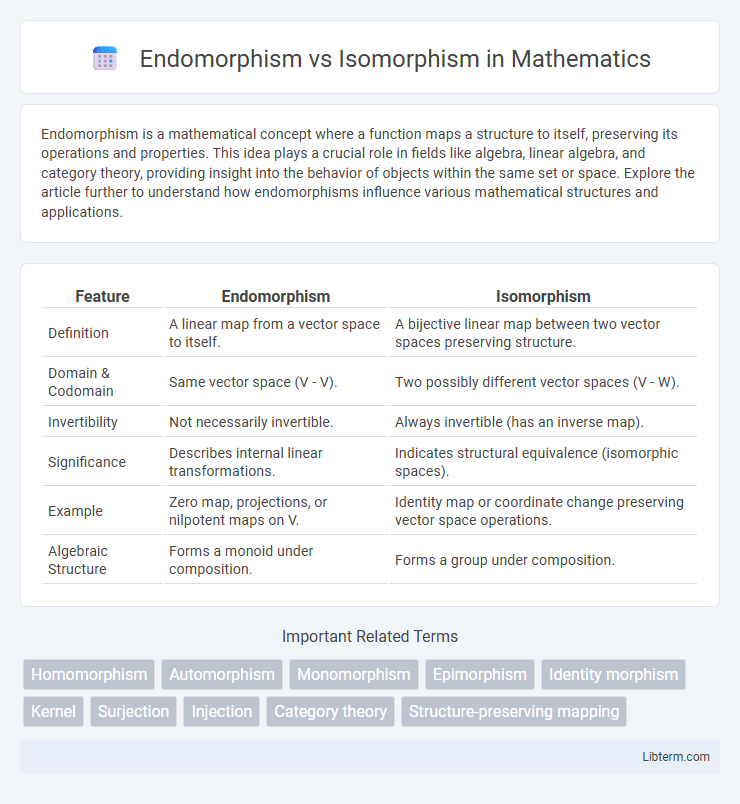Endomorphism is a mathematical concept where a function maps a structure to itself, preserving its operations and properties. This idea plays a crucial role in fields like algebra, linear algebra, and category theory, providing insight into the behavior of objects within the same set or space. Explore the article further to understand how endomorphisms influence various mathematical structures and applications.
Table of Comparison
| Feature | Endomorphism | Isomorphism |
|---|---|---|
| Definition | A linear map from a vector space to itself. | A bijective linear map between two vector spaces preserving structure. |
| Domain & Codomain | Same vector space (V - V). | Two possibly different vector spaces (V - W). |
| Invertibility | Not necessarily invertible. | Always invertible (has an inverse map). |
| Significance | Describes internal linear transformations. | Indicates structural equivalence (isomorphic spaces). |
| Example | Zero map, projections, or nilpotent maps on V. | Identity map or coordinate change preserving vector space operations. |
| Algebraic Structure | Forms a monoid under composition. | Forms a group under composition. |
Introduction to Endomorphism and Isomorphism
Endomorphism is a homomorphism from a mathematical structure to itself, preserving its operations and properties within the same set. Isomorphism refers to a bijective homomorphism between two structures that ensures an exact correspondence, indicating they are structurally identical. Both concepts are fundamental in abstract algebra for analyzing the internal symmetries and equivalences of algebraic systems.
Defining Endomorphism: Key Concepts
Endomorphism is a structure-preserving map from a mathematical object to itself, such as a linear transformation from a vector space to the same vector space. This concept plays a crucial role in abstract algebra and linear algebra by analyzing the internal symmetries and invariant properties of algebraic structures like groups, rings, or modules. Understanding endomorphisms allows mathematicians to explore the composition, fixed points, and decomposition of objects, differentiating it from isomorphisms which require bijectivity and focus on structural equivalence between different objects.
Understanding Isomorphism: Fundamental Principles
Isomorphism represents a bijective homomorphism between algebraic structures, ensuring a perfect structural match that preserves operations and relations. It guarantees that two systems are fundamentally identical in form and function, allowing seamless translation between elements without loss of information. Understanding isomorphism involves recognizing these critical properties of bijection, operation preservation, and structural equivalence.
Mathematical Structures Involved
Endomorphisms are structure-preserving maps from a mathematical structure to itself, such as linear transformations within vector spaces or homomorphisms within groups. Isomorphisms are bijective endomorphisms that establish structural equivalence between two mathematical objects, ensuring the preservation of operations and relations in both directions. In algebraic contexts like groups, rings, and vector spaces, isomorphisms confirm that two structures are fundamentally identical by maintaining both the internal composition and invertibility of the mapping.
Properties of Endomorphisms
Endomorphisms are structure-preserving maps from a mathematical object to itself, exhibiting properties like closure under composition and existence of an identity morphism. They form a monoid under function composition, with the set of all endomorphisms often denoted as End(X) for an object X. Unlike isomorphisms, endomorphisms need not be invertible but still play a crucial role in studying algebraic structures such as groups, rings, and vector spaces.
Characteristics of Isomorphisms
Isomorphisms are bijective morphisms between algebraic structures that preserve operations and relations, ensuring a one-to-one correspondence that reflects structural equivalence. Each isomorphism has an inverse that is also a morphism, highlighting the concept of symmetry in algebraic mappings. The characteristic property of isomorphisms is their ability to map elements without loss of information, preserving both algebraic operations and identity elements.
Major Differences: Endomorphism vs Isomorphism
Endomorphism is a homomorphism from a mathematical object to itself, preserving the object's structure within the same set. Isomorphism is a bijective homomorphism between two mathematical objects, indicating that the objects have identical structures and are structurally indistinguishable. The major difference lies in endomorphism mapping an object onto itself, whereas isomorphism establishes a one-to-one correspondence between two distinct objects.
Examples in Algebra and Other Fields
Endomorphisms appear in algebra as linear transformations from a vector space to itself, such as the identity map on \( \mathbb{R}^n \) or a projection operator, while isomorphisms represent bijective mappings preserving structure, exemplified by the rotation group \( SO(3) \) isomorphic to itself through conjugation or the group isomorphism between \( \mathbb{Z}_6 \) and \( \mathbb{Z}_2 \times \mathbb{Z}_3 \). In other fields like topology, an endomorphism corresponds to a continuous map from a space to itself, whereas a homeomorphism (isomorphism in topology) guarantees topological equivalence between spaces. Category theory abstracts these concepts, with endomorphisms as morphisms from an object to itself and isomorphisms as invertible morphisms, crucial for identifying objects sharing identical categorical structure.
Applications in Mathematics and Beyond
Endomorphisms play a crucial role in abstract algebra and functional analysis by describing structure-preserving maps from a mathematical object to itself, often used to study invariant properties and symmetries within algebraic systems such as groups, rings, and vector spaces. Isomorphisms serve as fundamental tools across mathematics and physics, enabling the classification of objects by establishing bijective mappings that preserve structure, thus proving two entities are essentially identical in their respective categories, which is vital in topology, group theory, and category theory. Beyond mathematics, isomorphisms find applications in computer science for data structure equivalences and cryptography for ensuring structural integrity, while endomorphisms assist in modeling dynamic systems and transformations in areas like quantum mechanics and coding theory.
Conclusion: Choosing between Endomorphism and Isomorphism
Choosing between endomorphism and isomorphism depends on the structural preservation required within algebraic systems; endomorphisms map a structure to itself, possibly altering its properties, while isomorphisms establish a bijective correspondence that preserves structural integrity. In algebra, isomorphisms are critical for proving equivalence between objects, ensuring identical algebraic behavior, whereas endomorphisms explore internal structure transformations and invariants. The decision hinges on whether the goal is to study internal symmetries or to confirm structural equivalence across distinct entities in mathematical frameworks.
Endomorphism Infographic

 libterm.com
libterm.com